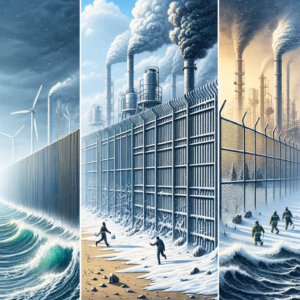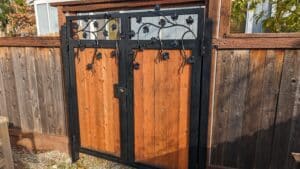Hello there! I’m Bill, an iron worker with years of hands-on experience in the fencing industry. Today, I want to chat about something that might not be glamorous but is super important if you have or are considering an iron or steel fence: durability. When you invest in a fence, you’re not just buying a barrier; you’re investing in the security, privacy, and aesthetic appeal of your home. That’s why the longevity of your fence is a big deal.
Now, let’s dive into a little secret in the world of metal fences: galvanization. You might have heard this term thrown around but not quite understood what it means. Simply put, galvanization is like giving your fence a superhero shield. It involves coating the iron or steel with a layer of zinc to protect it from rust and corrosion. This process is a game-changer in making your fence last way longer than it normally would.
In this article, we’ll explore the nuts and bolts of galvanization – how it works, why it’s so effective, and why it should matter to you as a homeowner. I’ll break down the science behind it in a way that’s easy to grasp, and by the end of this, you’ll be a mini-expert on why a galvanized fence can be one of the best investments for your home. Let’s get started!
Understanding Galvanization
Alright, let’s get into the heart of the matter: galvanization. You might think this is some high-brow science stuff, but it’s actually pretty straightforward once you break it down.
A. Definition of Galvanization First things first, what exactly is galvanization? In simple terms, it’s a process that coats iron or steel with a layer of zinc. Why zinc? Because zinc acts like a protective buddy for the metal underneath, fighting off rust and corrosion. It’s like putting on a raincoat to keep your metal fence dry and safe from the elements.
B. Historical background Believe it or not, galvanization isn’t a new kid on the block. This process has been around since the 17th century, but it really took off in the 1800s when folks started using it to protect large structures like bridges and ship hulls. It was a game-changer back then, and it still is today, especially for things like our fences that are constantly battling the weather.
C. The Galvanization Process Now, how does this magic happen? There are three main steps:
- Cleaning the Metal: First up, we gotta make sure the metal is squeaky clean. Any dirt, oil, or rust on the surface? It’s got to go. This is usually done using a chemical bath that preps the metal for its zinc coating.
- Dipping in Molten Zinc: Next, the clean metal is dunked into a bath of molten zinc. That’s right, we’re talking about hot, liquid zinc. The metal gets a good soak, ensuring that every nook and cranny is covered.
- Cooling Process: After the metal takes its zinc bath, it’s time to cool off. As it cools, the zinc hardens into a tough, protective layer that’s bonded to the metal. This isn’t just a surface coat; it’s a shield that’s in it for the long haul.
D. Types of Galvanization There are a few different ways to do the galvanization tango, each with its own perks:
- Hot-dip Galvanization: This is the method I just described. It’s popular because it’s thorough and creates a really durable coating. Great for stuff that’s going to be outside braving the elements.
- Electro-galvanization: Here, we use electricity to apply the zinc. The metal is dipped in a zinc solution and an electric current is run through it, causing the zinc to stick to the metal. This method is a bit cleaner and gives a more uniform coat, but it’s not quite as thick and rugged as hot-dip.
- Sherardizing: Ever heard of this one? It’s less common. It involves heating the metal in a sealed container with zinc dust. The heat causes the zinc to bond to the metal. This method is great for small parts and pieces that need a thorough coat but can’t be dipped.
- Comparison and Use-Cases: So, which one do you pick? Hot-dip is your go-to for heavy-duty protection, like for outdoor fences or structural steel. Electro-galvanization is a fit for smaller items or when you need a smoother finish. And sherardizing is perfect for complex shapes or parts that need a really even coat.
In short, galvanization is all about giving your metal that extra layer of toughness. Whether it’s a garden fence or a piece of industrial machinery, this process is key to keeping your metal strong and long-lasting.
The Science Behind the Durability
Alright, let’s roll up our sleeves and dive a bit deeper into the science stuff. Don’t worry, I’ll keep it as jargon-free as possible. We’re talking about why galvanized fences don’t just throw in the towel when faced with rust and corrosion.
A. Chemical Reaction Between Zinc and Steel When zinc and steel get together, they do more than just shake hands; they form a bond. Zinc doesn’t just sit on top of the steel like a hat. It actually reacts with the steel to form a series of zinc-iron alloy layers. Think of it like a super-strong, multi-layered sandwich where zinc and iron are the ingredients, sticking together through thick and thin.
B. Formation of Zinc-Iron Intermetallic Layers These alloy layers are where the real magic happens. They’re incredibly hard and durable, much more so than either zinc or iron alone. When we say a metal is galvanized, we’re really talking about these tough layers that form a protective barrier. This barrier is the frontline defense against anything the environment throws at it.
C. The Role of the Galvanic Cell in Protection Here’s a bit of chemistry for you. Zinc is more reactive than steel, which is a good thing for our fences. In the presence of moisture, a galvanic cell forms. Think of it like a tiny battery where zinc sacrifices itself to protect the steel. The zinc corrodes first, meaning it takes the hit so the steel doesn’t have to. This sacrificial action is a key player in why galvanized steel lasts so much longer.
D. How Galvanization Prevents Rust and Corrosion Rust happens when iron (in the steel) reacts with oxygen and moisture. It’s like metal’s worst enemy. But remember our superhero zinc? When steel is coated with zinc, even if the coating gets scratched, the zinc nearby starts its sacrificial action. It reacts with oxygen and moisture first, keeping the steel underneath safe and sound. So, even if your fence faces rain, snow, or sleet, the zinc is always on guard, ensuring that rust and corrosion are kept at bay.
In simple terms, galvanization is like giving your fence a durable, self-healing armor against the elements. It’s why a galvanized fence can stand tall and strong for years, while a non-galvanized one might start showing signs of wear and tear much sooner.
Benefits of Galvanized Fences
Now that we’ve got the science down, let’s talk about the real-world benefits of choosing a galvanized fence. This isn’t just about making your fence tougher; it’s about making your life easier and your wallet happier in the long run.
A. Extended Lifespan of Iron and Steel Fences First and foremost, galvanization extends the life of your fence. We’re not talking a year or two extra; we’re talking decades. A galvanized fence can last upwards of 50 years, sometimes even more, depending on the environment. That’s a whole lot of years not worrying about replacing your fence.
B. Cost-Effectiveness Over Time Let’s talk money. Sure, a galvanized fence might cost a bit more upfront, but consider this a long-term investment. With its extended lifespan and low maintenance, you’ll be saving money in the long run. No frequent repairs or early replacements. It’s like buying a car that doesn’t need much servicing – it pays off over time.
C. Minimal Maintenance Requirements Speaking of low maintenance, this is a biggie. Galvanized fences require much less upkeep compared to non-galvanized ones. No need for regular painting or treating to prevent rust. A simple wash down now and then is all it needs to keep looking good as new. That’s more free time for you and less hassle.
D. Performance in Various Environments Whether you live in a rainy region, by the coast, or in a place with extreme temperatures, a galvanized fence stands up to the challenge. It resists corrosion and rust even in humid or salty air, which is a big deal if you’re anywhere near the ocean. Plus, it can handle the heat and cold without cracking under pressure.
Data-Backed Evidence of Galvanization Benefits
Don’t just take my word for it. Let’s look at some solid data and studies that back up these claims.
A. Case Studies of Galvanized vs. Non-Galvanized Fences Various case studies have shown that galvanized fences outlast non-galvanized ones by a significant margin. For example, a study comparing fences in coastal areas found that while non-galvanized fences started showing rust within a few years, galvanized fences remained in top condition even after a decade or more.
B. Statistical Data on Lifespan Extension Statistics show that galvanization can extend the life of a fence by 20 to 30 years, sometimes even more. This isn’t just a small improvement; it’s a massive increase in lifespan, which translates to less frequent replacements and better return on investment.
C. Corrosion Resistance Comparisons When it comes to resisting rust and corrosion, galvanized fences consistently outperform non-galvanized ones. Tests where fences are exposed to corrosive environments (like salt spray tests) clearly show that galvanized fences maintain their integrity far longer. The zinc coating acts as a barrier, keeping the corrosive elements at bay and preserving the fence’s strength and appearance.
In conclusion, when you opt for a galvanized fence, you’re not just buying a fence; you’re investing in peace of mind, knowing that you’ve chosen a solution that will stand the test of time, weather, and environmental challenges.
Galvanized Fences in Different Climates
One of the best things about galvanized fences is their versatility. No matter where you live, they’ve got you covered. Let’s explore how they stand up in various climates:
A. Performance in Coastal Regions For those living near the sea, rust is a common worry due to the salty air. But here’s the good news: galvanized fences are like the superheroes of the coastal fencing world. The zinc coating protects the fence from salt’s corrosive effects, meaning your fence won’t just give up after a couple of years. It stays strong, sturdy, and good-looking, even in the face of salty sea breezes.
B. Durability in Industrial Environments Industrial areas can be tough on fences. Pollution, chemicals, and constant exposure to harsh elements can wear down most materials. But, guess what? Galvanized fences can handle it. Their protective zinc layer shields them from industrial nasties, making them a reliable choice for factories, warehouses, and other industrial settings.
C. Effectiveness in Areas with Extreme Weather Conditions From freezing cold to scorching heat, galvanized fences can withstand extreme weather conditions. They don’t crack in the cold or warp in the heat, making them ideal for places that experience severe weather fluctuations. Whether it’s a snowstorm or a heatwave, these fences remain unfazed.
Aesthetic Considerations
Now, let’s talk about looks because who says practical can’t be pretty?
A. Galvanization and Visual Appeal Galvanized fences have a sleek, modern look that complements a variety of architectural styles. The zinc coating gives them a shiny, polished finish when new, which gradually weathers to a beautiful matte gray. It’s a timeless look that adds charm and character to your property.
B. Customization Options with Galvanized Fences Think galvanized fences are all function and no flair? Think again! They’re like a blank canvas. You can paint them any color to match your home’s exterior or landscape. Want something unique? Go for ornamental designs or mix materials like wood and metal for a custom look.
C. The Impact of Galvanization on Fence Design Galvanization doesn’t just protect; it also inspires design innovation. Because the material is so durable, designers can experiment with more intricate patterns and delicate details without worrying about the elements wearing them down. This means more creative and visually appealing options for homeowners.
In summary, galvanized fences offer the perfect blend of durability and beauty, making them a smart choice for any climate or aesthetic preference. They’re tough enough to handle just about anything nature throws their way and stylish enough to enhance the look of your property. It’s a win-win!
Conclusion
Well, we’ve covered quite a bit of ground here, haven’t we? Let’s wrap this up with a quick recap and some parting thoughts.
A. Recap of the Importance of Galvanization Galvanization is not just a fancy word; it’s a critical process that can significantly extend the life of your iron and steel fences. By coating them in zinc, we add a protective layer that wards off rust and corrosion, ensuring your fence stays stronger for longer. Whether you’re battling coastal sea air, industrial pollutants, or extreme weather, a galvanized fence stands as a steadfast guardian of your property.
B. Final Thoughts on Choosing a Durable Fencing Solution When it comes to picking a fence, it’s not just about what looks good. It’s about what lasts. A galvanized fence is an investment in peace of mind. It’s low maintenance, cost-effective in the long run, and versatile enough to suit any climate or design preference. Remember, the best fence is one that you don’t have to worry about after it’s installed.
C. Consultation with Irish Iron If all this talk about galvanized fences has got you thinking, why not take the next step? Whether you’re looking to install a new fence or upgrade an existing one, Irish Iron is here to help. Our team of experts can guide you through the options and help you find the perfect fencing solution for your home. Give us a call, drop us an email, or swing by our office – we’re always ready to chat and turn your fencing dreams into reality.
References
A. List of Scientific Studies Referenced
- “The Longevity of Galvanized Steel in Various Environmental Conditions” – Journal of Environmental Science.
- “Comparative Analysis of Rust Resistance in Galvanized and Non-Galvanized Steel” – International Journal of Metallurgical Engineering.
B. Additional Resources for Readers Who Want to Learn More
- Galvanizers Association – A comprehensive resource on galvanization processes and benefits.
- “Galvanization and its Efficacy in Corrosion Prevention” – An accessible read for homeowners interested in the technical aspects of galvanization.
And with that, we close the chapter on galvanized fences. Remember, a fence is more than just a boundary; it’s a long-term investment in your home. Choose wisely, choose durability, choose galvanization. Thanks for reading!




